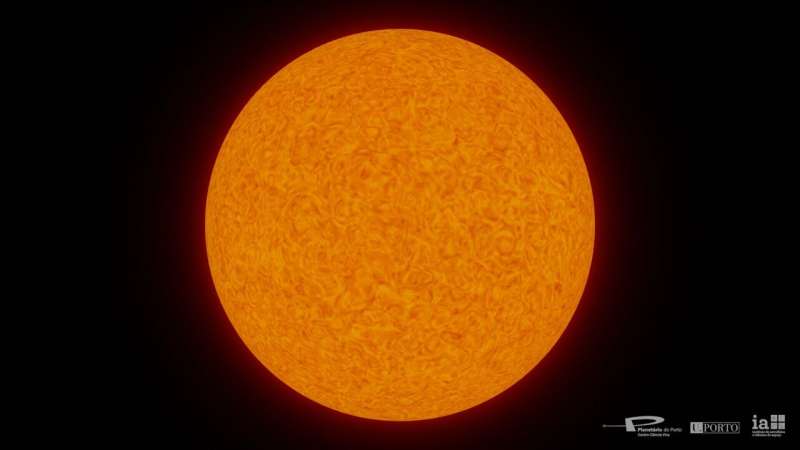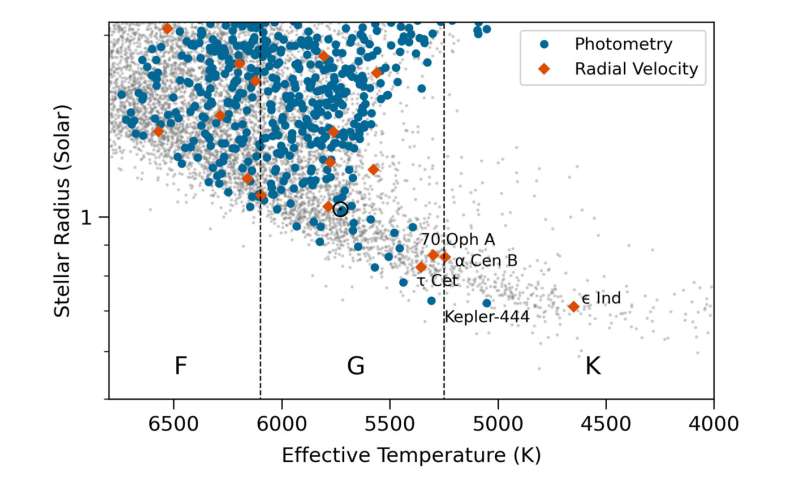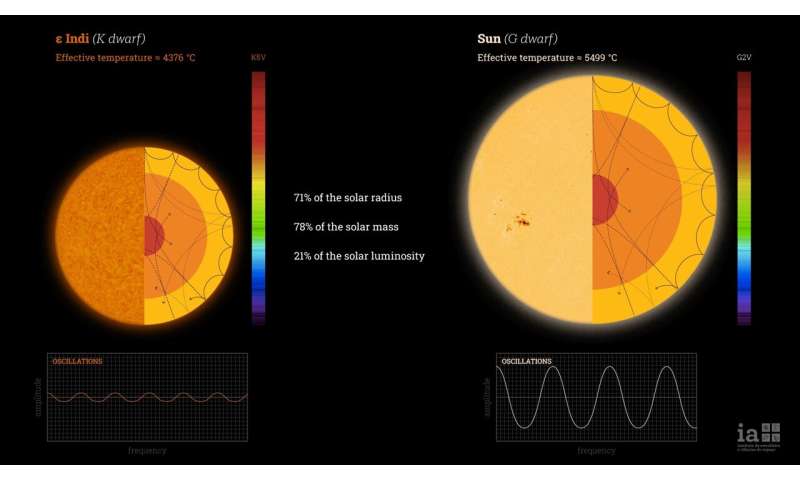At a distance of 11.9 light years, Epsilon Indi (ε Indi) is an orange dwarf star (also known as a K dwarf) with 71% of the sun’s diameter. An international team, led by Instituto de Astrofísica e Ciências do Espaço (IA) researcher Tiago Campante, studied this star with the ESPRESSO spectrograph, mounted at the European Southern Observatory’s (ESO) Very Large Telescope (VLT), and detected the tiniest “starquakes” ever recorded.
The team used a technique dubbed asteroseismology, which measures oscillations in stars. These provide indirect glimpses of stellar interiors, just as earthquakes tell us about Earth’s interior. In ε Indi, the peak amplitude of the detected oscillations is just 2.6 centimeters per second (about 14% of the sun’s oscillation amplitude), which makes it the smallest and coolest dwarf star observed to date with confirmed solar-like oscillations.
These measurements are so precise that the detected speed is slower than the average speed of a sloth.
“The extreme precision level of these observations is an outstanding technological achievement. Importantly, this detection conclusively shows that precise asteroseismology is possible down to cool dwarfs with surface temperatures as low as 4,200 degrees Celsius, about 1,000 degrees cooler than the sun’s surface, effectively opening up a new domain in observational astrophysics,” comments Campante, assistant professor at the Dept. of Physics and Astronomy of the Science Faculty of the University of Porto (DFA-FCUP).
This level of precision might help scientists settle a long-standing disagreement between theory and observations in what concerns the relation between the mass and the diameter of these cool-dwarf stars.
“Stellar evolution models are known to underestimate the diameter of K dwarfs by 5-15% compared to the diameter obtained from empirical methods. The study of oscillations in K dwarfs, via asteroseismology, will help identify the deficiencies of current stellar models and, thus, improve them so as to eliminate this discrepancy,” explains IA researcher Margarida Cunha.
These “starquakes” can now be used to help plan the future European Space Agency’s (ESA) PLATO space telescope, a mission in which IA is strongly involved. The oscillation amplitudes measured in this study can be converted to amplitudes in photometry, as they will be measured by PLATO, this being a key piece of information to help accurately predict the seismic yield of PLATO, scheduled to be launched in 2026.

Despite some initial skepticism that the detection of such oscillations could be beyond the reach of our current instrumental capabilities, Mário João Monteiro (IA & DFA-FCUP) explains that “Further to detecting the presence of solar-like oscillations in ε Indi, we now hope to use the oscillations to study the complex physics of the surface layers in K dwarfs. These stars are cooler and more active than our sun, making them important laboratories to probe key phenomena taking place at their surface layers that we have not yet studied in detail in other stars.”
On why the team used ESPRESSO, Nuno Cardoso Santos (IA & DFA-FCUP), leader of the “Towards the detection and characterization of other Earths” research group at IA, said, “An international consortium co-led by IA has developed the ESPRESSO spectrograph. The main goals of ESPRESSO are to detect and characterize low-mass planets orbiting other stars and to study the variability of the physical constants of nature. This result shows the potential of the ESPRESSO spectrograph to study other state-of-the-art science cases.”
Since orange dwarf stars and their planetary systems have very long lifespans, they have recently become a primary focus in the search for habitable worlds and extraterrestrial life.
-

Stellar radius versus effective temperature diagram, highlighting seismic detections from Kepler and TESS photometry (blue circles) and radial velocity (red diamonds) campaigns. The dashed lines delimit the stars’ spectral classes. Credit: Campante et al., 2024
-

Infographics comparing the orange (K dwarf) star ε Indi with the Sun. Credit: Paulo Pereira (Instituto de Astrofísica e Ciências do Espaço)
This result demonstrates that the power of asteroseismology can now potentially be put to use in the detailed characterization of such stars and their habitable planets, with truly far-reaching implications. Moreover, the precise determination of the ages of nearby cool dwarfs made possible by asteroseismology may be critical in interpreting biosignatures in directly imaged exoplanets.
“Every time we open a new window into nature, new surprises drive us into new unexpected discoveries. ε Indi holds the promise of being such a window with a bright view,” comments Mário João Monteiro.
The research is published in the journal Astronomy & Astrophysics.
More information:
Campante et al, Expanding the frontiers of cool-dwarf asteroseismology with ESPRESSO. Detection of solar-like oscillations in the K5 dwarf ϵ Indi, Astronomy & Astrophysics (2024). DOI: 10.1051/0004-6361/202449197
Provided by
Institute of Astrophysics and Space Sciences
Citation:
Tiniest ‘starquakes’ ever detected (2024, March 26)
retrieved 26 March 2024
from
This document is subject to copyright. Apart from any fair dealing for the purpose of private study or research, no
part may be reproduced without the written permission. The content is provided for information purposes only.